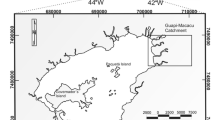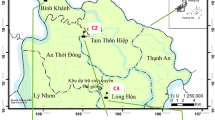Abstract
Large quantities of sediment are transported by the River Ganga (The Ganges) particularly In its deltaic region. Attempts have been made to study the physicochemical parameters of the bottom sediments of the River Ganga at various depths at Kamarhati and along the banks of the River Ganga in the lower deltaic region. The results give vital information regarding the pollution load carried by the river and the enrichment of its sediments with nutrients such as P, N and other substances such as C and S (as sulphates). The mobilization of the P, N, C and S (as sulphates) in the sediments is compared with their natural abundance. The enrichment of the river beds with P, the interaction of the sediment and the characteristics of the sediments are ascertained. Some aspects of the phosphorus cycle and its importance are also discussed. The recycling and reuse of sediments for agricultural purposes have been proposed in order to restore ecological imbalances due to nutrient loss.
Similar content being viewed by others
References
Black, C.A. (1965)Methods of Soil Analysis. Part-2. Madison, WI: American Society of Agronomy Inc.
Bowen, H.J.M. (1979)Environmental Chemistry of the Elements. Academic Press.
Chattopadhyay, M., Mukherjee, D. and Lahiri, S.C. (1993)J. Ind. Chem. Soc.,70, 56–8.
Edzwald, J.K. (1977) Fate of pollutants in the air and water environments. In H.I. Suffet (ed.)Advances in environmental science and technology. pp. 183–213. John Wiley and Sons, Inc.
Francis, A.J. and Dodge, C.J. (1988)Appl. Environ Microbiol. 54, 1009–14.
Goldberg, E.D., Griffin, J.J., Hodge, V., Koide, M. and Windom, H. (1979) Pollution history of the Sarannah River estuary.Environmental Science and Technology,13, 588–94.
Grant, W.D. and Long, P.E. (1981)Environmental Microbiology. Glasgow and London: Blackie and Sons, Ltd.
Handa, B.K. (1980)IAWPC Technical Annual 6–8, 15.
Jackson, M.L. (1960)Soil Chemical Analysis. Englewood Cliffs, NJ: Prentice Hall Inc.
Kouadio, I. and Trefry, J.H. (1987) Sediment trace metal contamination in the Ivory Coast, West Africa.Water, Air and Soil Pollution 32, 145–64.
Martin, J.K. and Meybeck, M. (1979) Elemental mass-balance of material carried by major world rivers.Marine Chemistry 7, 173–206.
Meybeck, M. (1982) Carbon, nitrogen and phosphorus transport by world rivers.American Journal of Science 282, 401–50.
Mukherjee, D., Chattopadhyay, M. and Lahiri, S.C. (1993) Water quality of the River Ganga (The Ganges) and some of its physico-chemical properties.The Environmentalist 13, 199–210.
Mukherjee, D., Das, J., Sarkar, G. and Lahiri, S.C.J. Ind. Chem. Soc. in press.
Oostdam, B.L. (1977) Fate of pollutants in the air and water environments. In H.I. Suffet (ed.)Advances in environmental science and technology. pp. 399–423. John Wiley and Sons, Inc.
Schropp, S.J., Calder, F.D., Burney, L.C. and Windom, H.L. (1989)Proceedings of the Sixth Symposium on Coastal and Ocean Management, 11–14 July, Charleston, South Carolina.
Sinarkar, S.M., Kesorwani, S.K. and Bhat, S.G. (1987) River Ganga.Overview of Environmental Research. Nagpur. India: NEERI.
Stoffers, P., Glasby, G.P., Wilson, C.J., Davise, K.K. and Walter, P. (1986) Heavy metal pollution in Wellington Harbour, New Zealand.Journal of Marine and Fresh Water Research 20, 495–512.
Stumm, W. and Leckie, J.O. (1971) Phosphate exchange with sediments. InProceedings of the Fifth International Conference on Water Pollution. Pergamon Press, New York.
Stumm, W. and Morgan, J.J. (1970)Aquatic Chemistry. New York: Wiley-Interscience.
Van Benneckom, A.J. and Solomons, W. (1981) Pathways of organic nutrients and organic matter from land to ocean through rivers. In J.M. Martin, J.D. Burton and D. Eisma (eds)Rivers input to the ocean system, pp. 33–51, Rome: UNESCO-UNEP, SCOR Workshop.
Welcher, F.J. (1963)Standard Methods of Chemical Analysis, 6th edn.
Author information
Authors and Affiliations
Additional information
Mrs M. Chattopadhyay (née Ray) and D. Mukherjee are both post-doctorate ex-senior research scholars within the Department of Chemistry, Kalyani University, where Professor S.C. Lahiri was until recently head of department. Mr S.K. Bhattacharya is director of the Ganga Action Plan Sector, Calcutta Metropolitan Development Authority, Unnayan Bhavan (1st floor), Salt Lake, Calcutta 700 091, India. The information given in this paper is supplementary to that provided by certain of the same authors inThe Environmentalist 13(3), 199–210.
Rights and permissions
About this article
Cite this article
Chattopadhyay, M., Mukherjee, D., Bhattacharya, S.K. et al. Studies on soil parameters of sediments from the River Ganga phosphorus mobilization, interactions with sediment and the phosphorus cycle. Environmentalist 15, 211–219 (1995). https://doi.org/10.1007/BF01901577
Issue Date:
DOI: https://doi.org/10.1007/BF01901577




